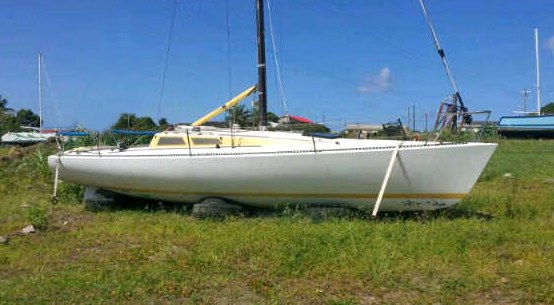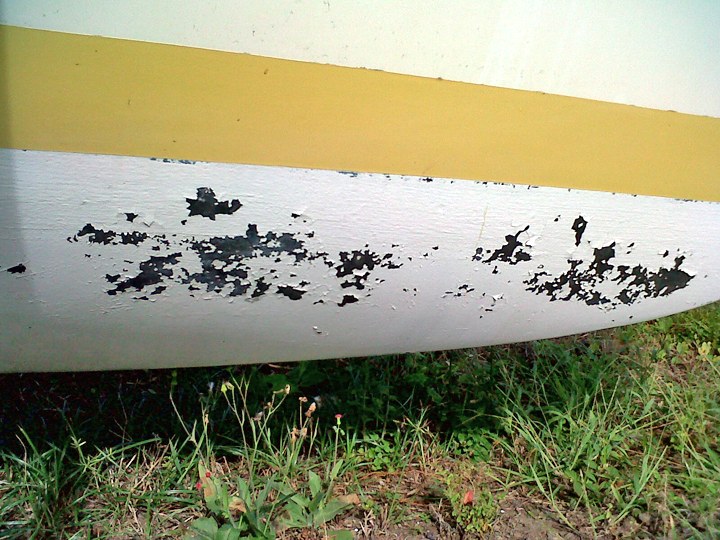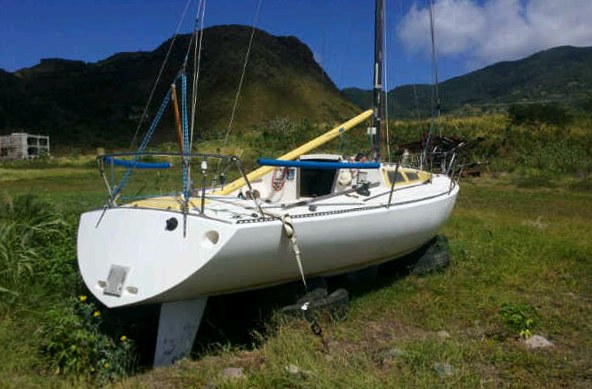
Out Standing in Her Field

This photo of the Olson 30 La Gamelle hauled out in St. Kitts cracks us up. After all, is there anything as incongruous as a boat hull deep in green grass? Fear not, she’s not missing her keel. Many boatyards in hurricane zones backhoe a hole for the keel, line it with tires, and then strap the boat down. In such a state, it’s difficult for boats to be blown over. Although in the case of a low-rider such as La Gamelle, we fear she may have become a home for any number of varmints — even Dacron-eating ones. We’ll soon find out, as we’ll be relaunching her for the Caribbean season in about two weeks.
If we’ve learned one thing in life, it’s that Clare Boothe Luce was correct when she said ‘no good deed goes unpunished.’ For instance, wanting to do a small bit for the environment, when it came time to paint the bottom of the La Gamelle Syndicate’s Olson 30 La Gamelle, we decided to go with ePaint’s zinc-based paint. The manufacturer assures us it doesn’t cause any harm to the environment. We’d rate the paint as below average for La Gamelle‘s time in the Oakland Estuary, but not bad for the Caribbean. Of course, we only had La Gamelle in the water in the Caribbean for three months before hauling her out for the off-season, so it wasn’t much of a test.

But as you can see from the accompanying photos, the paint has developed an unfortunate tendency to flake off, something not particularly conducive to boat speed. So the way we see it, we’re faced with three options: 1) Remove all the ePaint with some kind of stripper — the soy-based kind has received some excellent reviews — then repaint from scratch. It sounds like dirty work, particularly when it would have to be done in the humid lee of St. Kitts, where the yard has absolutely no supplies of any kind. 2) Sand away the flaking material, then have another go at it with more ePaint. The obstacles to this option are that we’re not sure how much of the paint has flaked off and that ePaint has no retailers in the Caribbean. In the old days we used to take gallons of bottom paint as carry-on baggage. The kill-joys don’t allow that anymore. 3) Our third option is to sand down — or find someone else to sand down — the flaking bits as well as the rest of the hull lightly, then paint it with some ablative bottom paint, preferably a type that sticks to just about any surface. We know there is a big chance that a new ablative paint would be incompatible with the ePaint and it might all fall off. But we tend to take risks. And it only has to last for three months. If it’s a complete disaster, we can have all the bottom paint removed next year.
Anybody have any experience with ePaint? Or thoughts on our earth-shaking dilemma? Email them to Richard.

By the way, we’ve got a couple of nice Olson 30 spinnakers, plus a pretty nice North Gatorback main with no reefs points. We’d rather have a pretty nice main — Dacron is no problem — with reef points. The main needs to have external slugs.
